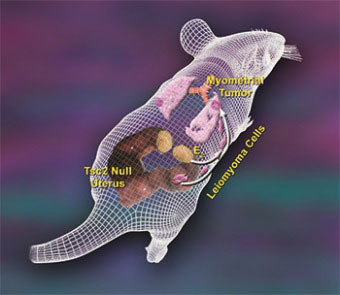Posted March 13, 2014
Stephen R Hammes, M.D., Ph.D., University of Rochester, Rochester, New York
 Lymphangioleiomyomatosis (LAM) is a rare lung disease in which abnormal smooth muscle cells proliferate out of control, leading to the loss of lung function. As a result of these tumors, approximately 50% of LAM patients will have at least one lung collapse, and over 30% will develop fluid in their lungs. Many LAM patients will require a lung transplant; however, the tumors may return. Genetic studies have shown that LAM cells contain mutations in one of the two tuberous sclerosis complex (TSC) genes, Tsc1 or Tsc2, and as many as 30%-40% of women with TSC may be affected by LAM in their lifetime. LAM is found almost exclusively in women and has similarities with uterine leiomyomas, benign tumors of myometrial cells, such as hormone sensitivity and exacerbation during pregnancy and hormonal contraception. Moreover, LAM tumors may recur after transplantation, suggesting that they may be the result of metastasis of another tumor in the body.
Lymphangioleiomyomatosis (LAM) is a rare lung disease in which abnormal smooth muscle cells proliferate out of control, leading to the loss of lung function. As a result of these tumors, approximately 50% of LAM patients will have at least one lung collapse, and over 30% will develop fluid in their lungs. Many LAM patients will require a lung transplant; however, the tumors may return. Genetic studies have shown that LAM cells contain mutations in one of the two tuberous sclerosis complex (TSC) genes, Tsc1 or Tsc2, and as many as 30%-40% of women with TSC may be affected by LAM in their lifetime. LAM is found almost exclusively in women and has similarities with uterine leiomyomas, benign tumors of myometrial cells, such as hormone sensitivity and exacerbation during pregnancy and hormonal contraception. Moreover, LAM tumors may recur after transplantation, suggesting that they may be the result of metastasis of another tumor in the body.
Supported by a Fiscal Year 2011 Tuberous Sclerosis Complex Research Program Exploration - Hypothesis Development Award, Dr. Stephen Hammes tested the hypothesis that LAM tumors, similar to uterine leiomyomas, originate from the uterine myometrium and that Tsc mutations provide the "additional hit" necessary to promote tumor growth and lymphatic spread to the lungs. To test this hypothesis, Dr. Hammes' team at the University of Rochester, led by graduate student Hen Prizant, created a mouse model for uterine leiomyomas and LAM by deleting the Tsc2 gene primarily in uterine cells. All of these mice developed uterine leiomyomas, recapitulating the condition observed in humans. Moreover, uterine cell proliferation was promoted by estrogen but not progesterone in ovariectomized Tsc2 null mice, mirroring the higher risk for LAM observed during pregnancy. Finally, analysis of lung tissue in older Tsc2 null mice revealed an infiltration of LAM-like, smooth muscle tumors in some of the animals, offering support for the hypoethesis that LAM tumors might originate from tumors in the uterus. This new mouse model has the potential to improve our understanding of LAM and leiomyomas and may lead to novel therapeutic strategies for both diseases.

Uterine-specific knockout of Tsc-2 in mice results in myometrial proliferation and leiomyoma formation by 18-24 weeks. By 30-34 weeks, the majority of uterine-specific Tsc-2 knockout mice develop myometrial tumors in their lungs, suggesting that uterine leiomyoma cells might migrate from the uterus to the lungs either through the vasculature or the lymphatics. Both leiomyoma formation and subsequent myometrial tumor growth are dependent on estradiol (E2) production from the ovaries. Thus, myometrial proliferation and metastasis appear to require two "hits": loss of Tsc1/2-mediated inhibition of mTORC1 and the presence of estradiol-stimulated cell growth.
The figure was provided by the Endocrine Society.
Publication:
Prizant H, Sen A, Light A, et al. 2013. Uterine-specific loss of Tsc2 leads to myometrial tumors in both the uterus and lungs. Molecular Endocrinology 27:1403-1417.
Links:














